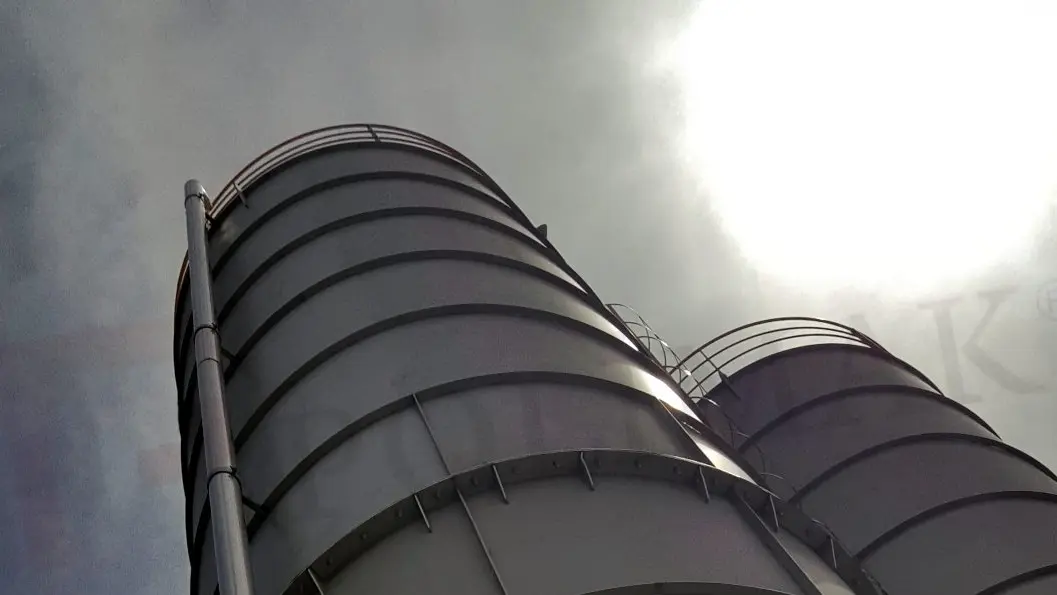Aeration, Flow Aids & Safety Systems
In operations involving silos for bulk handling, ensuring reliable material flow and maintaining operational safety are just as critical as the loading and unloading processes. Many powders and granular bulk solids are prone to issues such as bridging, rat-holing, or compaction inside silos. These problems often intensify under changing humidity or temperature conditions. To ensure consistent flow and operator safety, bulk handling systems are often equipped with aeration, flow aids, and critical safety devices.

How the System Operates
• Aeration Systems: Low-pressure air is introduced at the silo bottom or along the cone using air pads, or fluidization nozzles. This equipment reduces internal friction and loosens compacted material. It enables smooth discharge, especially for fine powders like cement, flour, or fly ash.
• Flow Aids & Vibratory Devices: Mechanical devices such as vibrators, bin activators, or air cannons are installed on silo walls or discharge cones. They are activated periodically or on demand to break up material blockages and restore flow.
• Pressure & Level Monitoring: Sensors monitor material level, air pressure, and flow status in real time. This mechanism ensures that the system operates within safe and efficient parameters, preventing overfilling, vacuum collapse, or bulk material buildup.
• Safety Systems & Emergency Devices: Pressure relief valves, explosion vents, or emergency shut-off valves are integrated to protect both equipment and personnel from overpressure events, fire risks, or other operational issues.

Key Components
• Silo Aeration Pads / Air Jets: Aeration pads or air jets are installed near the discharge outlet of the silo to help fluidize the bulk solid. When pressurized air is applied, the material becomes more free-flowing, improving silo discharge efficiency.
• Bin Activators: Bin activators are devices installed at the outlet of silos to promote the flow of bulk materials. They use vibration or mechanical movement to prevent material bridging and ensure smooth discharge.
• Silo Pressure Sensor: Silo pressure sensors measure the air pressure inside the silo and send signals to the control or automation systems to monitor the pressure levels. Can be integrated into plant SCADA or PLC systems.
• Pressure Relief Valves: A silo pressure relief valve prevents excessive pressure buildup inside the silo, especially during pneumatic filling. If the pressure exceeds a set limit, the valve vents the silo to maintain safe, low pressure levels, making it a crucial safety device for bulk solid storage.
• Emergency Shutoff Valves: Installed in discharge lines or silo outlets to instantly stop flow in hazardous situations or system failures.

Advantages & Key Benefits of Aeration, Flow Aids & Safety Systems
• Reliable Material Flow: Prevents flow stoppages caused by flow issues such as bridging or rat-holing, ensuring consistent operations and avoiding costly downtime.
• Optimized Discharge Efficiency: Flow aids help achieve complete emptying of silos, reducing material waste and improving handling efficiency.
• Improved Operator Safety: Automated systems reduce the need for manual intervention. Overpressure protection and grounding systems prevent accidents and equipment damage.
• Compliance with Regulations: Safety equipment such as pressure relief ensure compliance with industry safety standards, including ATEX, NFPA, and OSHA.
• Reduced Maintenance: Proactive flow management minimizes possible damage on downstream equipment and reduces the need for manual cleaning or unclogging.

Industry-Specific Examples
• Cement & Building Materials: Silo aeration pads and air jets are commonly installed near silo discharge outlets to fluidize high-density powders such as cement and gypsum, preventing clogging. Bin activators provide additional vibration to ensure smooth flow. Pressure relief valves and emergency shutoff valves protect silos from overpressure and hazardous situations, while pressure sensors monitor internal silo conditions to optimize safety and efficiency. Explosion vents are also fitted on top of large silos to comply with local fire codes.
• Food & Beverage: Vibratory bin activators and aeration pads are used to handle delicate materials like flour, sugar, and starch without causing degradation or contamination. Stainless steel pressure relief valves ensure hygienic and safe pressure management, and silo pressure sensors enable real-time monitoring of storage conditions. Emergency shutoff valves are installed in discharge lines for quick isolation during emergencies.
• Chemical Industry: Sensitive powders prone to compaction are managed through a combination of silo aeration pads and bin activators that facilitate smooth flow and prevent bridging. ATEX-certified pressure relief valves and emergency shutoff valves ensure compliance with explosion protection regulations. Silo pressure sensors are integrated into plant automation systems for continuous pressure monitoring and control.
• Plastic & Polymer Industry: Resin pellets and powders are discharged efficiently using air jets and bin activators that aid in flow while anti-static grounding systems mitigate fire or static hazards. Pressure relief valves protect against pressure surges during pneumatic filling, with silo pressure sensors providing critical data to SCADA systems. Emergency shutoff valves enable immediate flow stoppage in case of system faults.